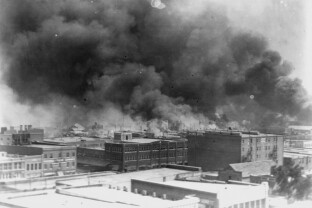The U.S. Department of Justice published the first federal review of the Tulsa Race Massacre on Friday in an effort to correct the historical record on the deadly attack on a vibrant Black community in Oklahoma.
The report said it was “clear that no avenue of prosecution now exists for these crimes” but added that the DOJ sought to preserve a historical record of the 1921 massacre. The report, which was highly anticipated by advocacy groups and locals, was announced in September and released in the final days of Joe Biden’s presidency.
“Until this day, the Justice Department has not spoken publicly about this race massacre or officially accounted for the horrific events that transpired in Tulsa,” Assistant Attorney General Kristen Clarke said in a release. “This report lays bare new information and shows that the massacre was the result not of uncontrolled mob violence, but of a coordinated, military-style attack on Greenwood.”
The more than 100-page report lays out how up to 10,000 white Tulsans violently attacked and destroyed the Black community of Greenwood, in what “transcended mere mob violence.”
In an interview prior to the report’s release, Vanessa Hall-Harper, a Democratic city councilor in Tulsa who represents Greenwood, told NOTUS she appreciates the DOJ’s efforts. But she said she believes this report and its timing are all about how the Democratic Party wants to appear as Biden leaves office.
“I think it was intentionally done very late in [Biden’s] administration when a lot more work and a lot more progress could have been made early on,” Hall-Harper said. “When the government procrastinates, that’s not by accident. And in my opinion, that is always done for one specific reason: to maintain the status quo.”
The DOJ did not comment beyond the report.
Survivors — two of whom are still alive — and their descendants have been pushing for reparations for years. The recent centennial anniversary of the massacre brought a lot of national attention to the history of the city, a departure from years of the Tulsa Race Massacre getting largely glazed over in history.
The report, which was compiled by the Emmett Till Cold Case Unit at the DOJ, captures the violence that spanned 35 blocks for two days as white Tulsans destroyed the prosperous area of Black businesses known as Black Wall Street. The account describes it as “initially chaotic” as the crowds demanded the lynching of a Black man who was arrested for allegedly assaulting a white woman but “became systematic” after many of the white Tulsans were deputized by Tulsa police.
A survivor “relayed an account of white men kicking in his door and grabbing his mother and sister, ransacking the house, and throwing a Molotov cocktail into his room, lighting it on fire,” in an interview by the Cold Case team.
The report found that under today’s laws, federal prosecutors could have pursued hate crime charges against public officials and private citizens who perpetrated the attack, but few avenues existed at the time.
Clarke is scheduled to meet with members of the Greenwood District after the report’s release, including survivors and descendants of the massacre and the Tulsa civil rights community, the release said.
“Ultimately, we hope the Department of Justice’s investigation brings long-overdue justice to the survivors and their descendants and leads to meaningful policy changes and actions that address the ongoing impacts of the legacy of slavery and racism in the U.S.,” said Bria Nelson, an advocate and attorney with Human Rights Watch, in an email ahead of the report’s release.
“We need to keep advocating for justice and never let these critical conversations slip away, no matter the political landscape.”
—
Em Luetkemeyer is a NOTUS reporter and an Allbritton Journalism Institute fellow.
Sign in
Log into your free account with your email. Don’t have one?
Check your email for a one-time code.
We sent a 4-digit code to . Enter the pin to confirm your account.
New code will be available in 1:00
Let’s try this again.
We encountered an error with the passcode sent to . Please reenter your email.


